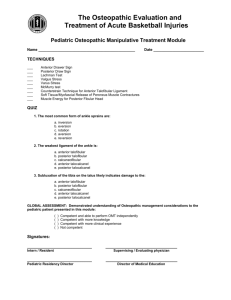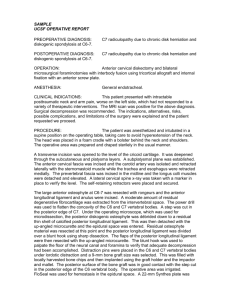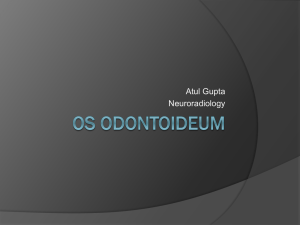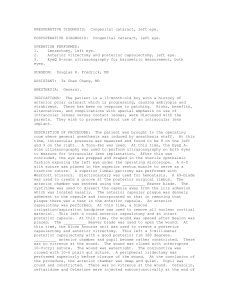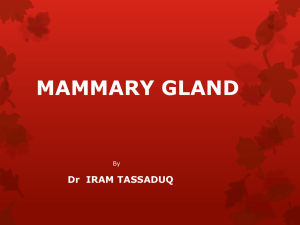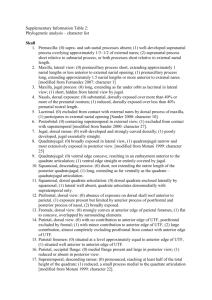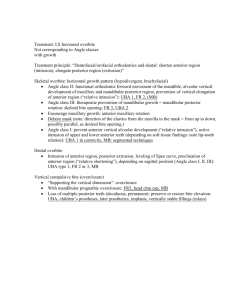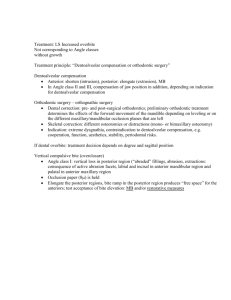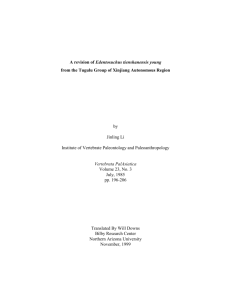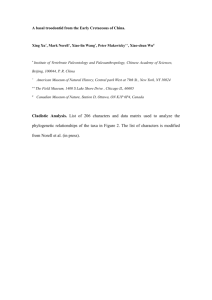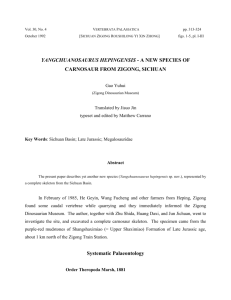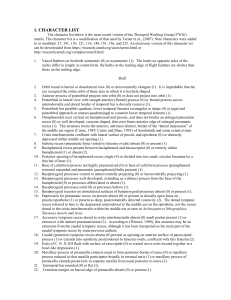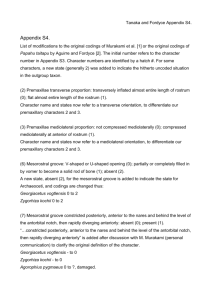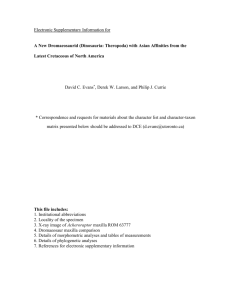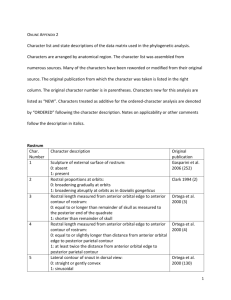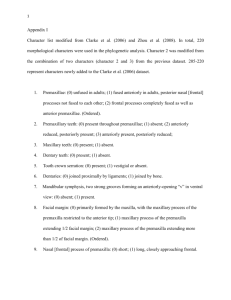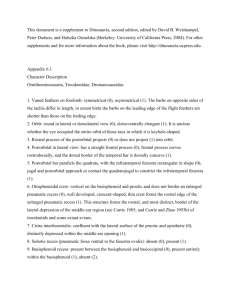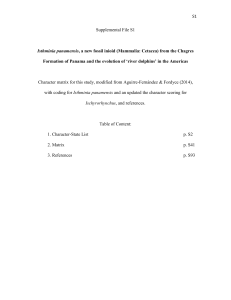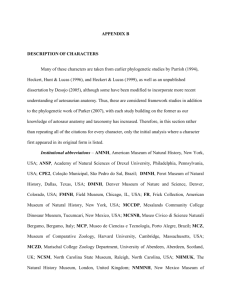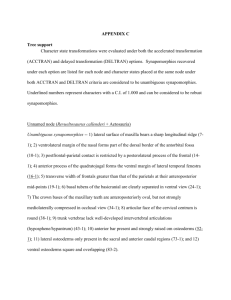Supplementary Information - Word file (31 KB )
advertisement
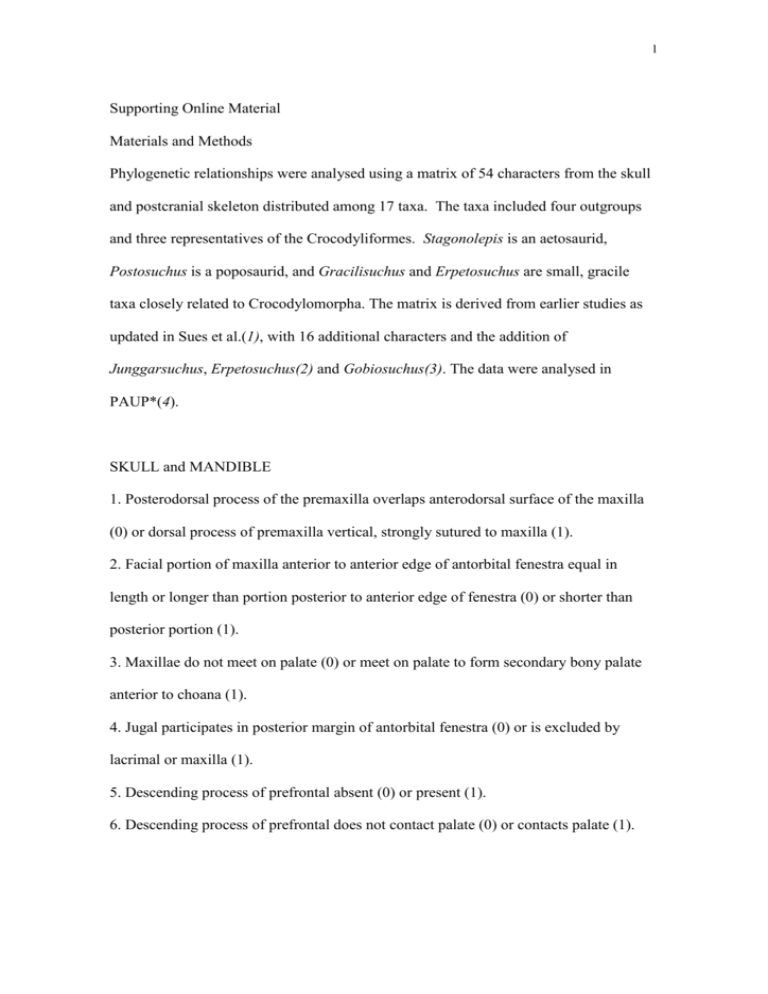
1 Supporting Online Material Materials and Methods Phylogenetic relationships were analysed using a matrix of 54 characters from the skull and postcranial skeleton distributed among 17 taxa. The taxa included four outgroups and three representatives of the Crocodyliformes. Stagonolepis is an aetosaurid, Postosuchus is a poposaurid, and Gracilisuchus and Erpetosuchus are small, gracile taxa closely related to Crocodylomorpha. The matrix is derived from earlier studies as updated in Sues et al.(1), with 16 additional characters and the addition of Junggarsuchus, Erpetosuchus(2) and Gobiosuchus(3). The data were analysed in PAUP*(4). SKULL and MANDIBLE 1. Posterodorsal process of the premaxilla overlaps anterodorsal surface of the maxilla (0) or dorsal process of premaxilla vertical, strongly sutured to maxilla (1). 2. Facial portion of maxilla anterior to anterior edge of antorbital fenestra equal in length or longer than portion posterior to anterior edge of fenestra (0) or shorter than posterior portion (1). 3. Maxillae do not meet on palate (0) or meet on palate to form secondary bony palate anterior to choana (1). 4. Jugal participates in posterior margin of antorbital fenestra (0) or is excluded by lacrimal or maxilla (1). 5. Descending process of prefrontal absent (0) or present (1). 6. Descending process of prefrontal does not contact palate (0) or contacts palate (1). 2 7. Prefrontal not underlying anterolateral edge of frontal to a significant degree (0) or with distinct posterior process underlying frontal dorsal to orbit (1). 8. Postfrontal present (0) or absent (1). 9. Dorsal surface of frontal flat (0) or with longitudinal median ridge (1). 10. Squamosal not significantly overhanging lateral temporal region (0) or with broad lateral expansion overhanging lateral temporal region (1). 11. Descending process of squamosal anterior to quadrate present (0) or absent (1). 12. Squamosal without ridge on dorsal surface along edge of supratemporal fossa (0) or with ridge (1). 13. Lateral edge of squamosal without (0) or with longitudinal groove (1). 14. Quadratojugal extending anterodorsally to contact postorbital (0) or not contacting postorbital (1). 15. Quadrate not in contact with prootic (0) or contacting prootic (1). 16. In presumed adults, parietals separate (0), interparietal suture partially obliterated (1), or interparietal suture absent (2). [Ordered.] 17. Posteroventral edge of parietals extending more than half the width of the occiput (0) or less than half the width of the occiput (1). 18. Medial margins of supratemporal fossae on lateral surfaces of parietals separated on midline by broad, flat area (0) or by sagittal crest (which may be divided by median sulcus) (1). 19. Occipital margin of parietals V-shaped in dorsal view (0) or straight (1). 20. Exoccipitals broadly separated dorsal to foramen magnum (0), approaching midline without contacting (1), or contacting below supraoccipital (2). [Ordered.] 3 21. Prootic broadly contacting anterior surface of paroccipital process (0) or not in broad contact (1). 22. Depression for mastoid antrum: absent (0), present on lateral surface of prootic dorsal to otic capsule (1), or entering deeply into prootic or connecting with each other through supraoccipital (2). [Ordered.] 23. Depression for posterior tympanic recess: absent (0), depression posterior to fenestra ovalis on anterior surface of paroccipital process (1), or penetrating prootic and paroccipital process (2). [Ordered.] 24. Paroccipital process dorsoventrally tall and distinctly expanded distally (0) or process narrower dorsoventrally, distal end only slightly expanded (1). 25. Basipterygoid processes of basisphenoid present (0) or absent (1). 26. Basipterygoid processes simple, without large cavity (0) or greatly expanded, with large cavity (1). 27. Articular without dorsomedial projection posterior to glenoid fossa (0) or with dorsomedial projection (1). 28. Posterior edge of maxillary and more posterior dentary teeth concave or straight (0) or distinctly convex (1). POSTCRANIAL SKELETON 29. Coracoid subcircular in lateral view (0), with elongate, tapering postglenoidal process posteromedially (1), with extremely elongate posteromedial process (2) or with elongate ventromedial process expanded ventrally (3). Modified from Sues et al. 3 to add state 2. 4 30. Proximal ends of metacarpals overlap (0) or abut one another without overlapping (1). 31. Proximal head of femur confluent with shaft (0) or with distinct, medially directed head set off from shaft (1). 32. Tibia/femur length ratio: less than 1 (0), greater than 1 (1). 33. Anterior edge of paramedian dorsal osteoderms straight (0) or with anterior process (1). 34. Paramedian dorsal osteoderms flat (0) or with distinct longitudinal bend near lateral edge (1). NEW CHARACTERS: SKULL and MANDIBLE 35. Basisphenoid body similar in size to basioccipital (0) or greatly expanded with pneumatic cavities (1) 36. Exoccipital does not contact distal end of quadrate (0) or contacts quadrate, enclosing internal carotid artery (1). 37. Jugal straight below infratemporal fenestra (0) or strongly arched dorsally (1). 38. Ventral edge of jugal flat or convex (0) or with longitudinal concavity (1) 39. Lateral end of paroccipital process convex (0) or concave (1). 40. Supratemporal portion of postorbital forms squared off anterolateral corner to rectangular skull roof (0) or postorbital with oblique, anterolaterally facing edge so that skull roof and supratemporal fenestra narrow anteriorly (1) 41. Horizontal shelf in posterior part of supratemporal fenestra poorly developed or absent (0) or well developed, flooring posterior 1/3 of supratemporal fossa (1) 5 42. Occipital portion of parietal narrow (0) or broad (1) 43. Surangular foramen absent (0) or present (1) 44. M. pterygoideus posterior insertion area on angular does not extend onto lateral surface (0) or extends well onto lateral surface (1). 45. Anterior maxillary teeth similar in size to posterior teeth (0) or much larger than posterior teeth (1) 46. Quadrate without fenestrae (0) or fenestrated (1). POSTCRANIAL SKELETON 47. Vertebral centra shallow amphicoelous (0) or procoelous (1) 48. Well developed hypapophyses absent on cervical vertebrae (0) or present (1) 49. Zygapophyses of anterior dorsal vertebrae sub-vertically oriented (0) or horizontal (1) 50. Osteoderms present (0) or absent (1) 51. Anterior and posterior borders of scapula similar, blade relatively narrow (0) or anterior edge more strongly concave than posterior, blade much broader (1) 52. Glenoid fossa on scapula ventrally or posteroventrally oriented (0) or posterolaterally oriented (1) 53. On distal end of ulna, medial articulation with elongate radiale not confluent with distal articulation with ulnare (0) or articulations confluent, distal end broadly arched (1) 54. First manus digit faces ventrally (0) or faces laterally, flexing towards digit II (1). 55. First metacarpal similar in thickness to second metacarpal or thicker (0) or more slender (1). 6 Outgroups Stagonolepis 00000 00000 00010 00010 00000 00000 00000 00000 0?00? 000?0 00N00 Gracilisuchus ?1?10 ??000 01010 1000? ???0? ?000? 00?10 00000 0000? 000?0 01??? Postosuchus 01000 ??000 1?000 01100 00000 00000 00??0 00000 01100 0001? 00N00 Erpetosuchus 1110? ??100 1100? 2011? ????0 00000 ??0?? 000?0 0?0?? 000?0 00N00 Crocodylomorpha Litargosuchus 00?1? ?1101 ?00?? 1100? ???0? ?011? ????? ???00 0??0? ????? ????? Pseudhesperosuchus 01??1 1?101 110?? 0?10? ????0 00?1? ?0??? 0??00 01?0? ?000? 000?0 Hesperosuchus 00?1? ?1111 1101? 0?10? ???00 11111 1?110 00000 01000 000?0 000?0 Saltoposuchus 00?1? ?1101 110?? 0?10? ????? ?0??1 1011? ?00?0 01000 00??0 ????0 Terrestrisuchus 00000 000?0 ?111? ?1101 100?? 0?001 1??0? ?011? 11??? 00000 01000 7 Kayentasuchus 0010? ???11 111?1 ?1001 11??? ?0??? 1?11? 0??0? 01?0? 0???0 ????? Dromicosuchus 00?1? ??111 110?? 0?10? ???0? ?112? 1011? ?0000 0??00 000?0 00??? Sphenosuchus 00111 01111 11011 21111 11100 1012? ????0 00000 01000 000?0 00??? Dibothrosuchus 00111 10111 1?011 21111 12010 10121 ??000 00001 11000 00000 00000 Junggarsuchus 00?11 0?111 110?1 21112 ???0? ?0121 ????1 11111 10111 11101 10011 Crocodyliform crocodylomorphs Protosuchus 11111 0?101 10101 21012 12211 ?013? 10111 11000 10000 100?0 10?00 Gobiosuchus 11111 10101 1??01 21?1? 1??11 ?103? ?1?00 10000 10000 100?? 0???? Alligator 1?1?1 10101 10101 21012 12011 ?0030 10002 11000 10001 11110 0100 N = inapplicable; ? = unknown. Supporting Online Material References 1. H.-D. Sues, P. E. Olsen, J. G. Carter, D.M. Scott. J. Vert. Paleont: 23, 329 (2003). 2. M.J. Benton, A.D. Walker, Zool. J. Linn. Soc., 136, 25 (2002). 8 3. H. Osmólska, S. Hua, E. Buffetaut, Acta Palaeont. Polon. 42, 257 (1997). 4. D.L. Swofford, PAUP* Beta 10 Software. (Sinauer Associates, Sunderland, MA, 2003).


